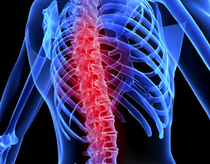Can treat paralysis with light
The technique of controlling nerve cells by light not only helps people with spinal injury to move limbs, but also can treat many other diseases.
Scientists have created a remote control 'switch' in nerve cells, by implanting a light-sensitive gene into it. Now the same technique is used to treat spinal cord injuries.
When the spinal cord is damaged, the signal that the brain emits cannot reach parts of the body. This situation makes us unable to move the limbs. It can even cause the diaphragm (preventing the lungs from the liver, stomach, spleen and other internal organs) from moving up and down so that the victim dies from not breathing.

Photo: evolutionnews.org.
Jerry Silver, a neuroscience doctor at Case Western Reserve University, wants to find out whether light-sensitive genes can stimulate the activity of nerve cells that control the diaphragm. He and his colleagues caused partial damage to rats' spinal nerves in the second vertebra (where the neck of the mouse rotates and contains nerve cells that control breathing activity). People also often suffer from trauma to the second neck vertebra.
Because there is no complete damage to the second neck vertebrae, one side of the diaphragm of the mouse is still working. Of course, their breathing activity is difficult. The team implanted a virus carrying Channelrhodopsin-2 (a light-sensitive protein) into nerve cells that control the diaphragm but located below the site of injury.
The mice's vertebrae were opened four days later. They still wheeze after being shown continuous beams of light. The team used light pulses of different durations. After projecting the pulses of light for a second, they found the mice breathing normally. Tests showed that the blood of the mice was provided with enough oxygen, while their diaphragm halves worked together smoothly.
Dr. Jerry Silver hopes that testing on mice may pave the way for human studies. According to him, the technique of light-sensitive protein implantation into neurons not only benefits patients with spinal cord injury, but also can help treat many other diseases, such as multiple sclerosis. It can also help us 'turn off' some physiological feelings like pain and cold.
How to bring light into neurons without having to dissect the patient's neck vertebrae is one of the problems that Dr. Jerry Silver wants to solve soon. A method has been devised to transplant a light source into the body. This light source can be activated and remote control. Another solution is to use micro-tubes to guide light. Jerry Silver said that the era of fiber optic will pave the way for a revolution in neurosurgery.
- Can treat hand paralysis
- Tango dancing helps treat paralysis
- Medical breakthrough: For the first time, paralysis patients can walk
- What is facial paralysis of actress Angelina Jolie?
- Panic when mouth distorted, face deviated after 1 night because of many habits people do on hot days
- Inject germ cells into the brain to cure paralysis due to stroke
- Cure cancer with light
- Chip helps the paraplegic
- The new virus causes paralysis in children
- Licking arbitrarily can cause paralysis, death
- Bacteria from the ocean floor help treat prostate cancer
- Control your wheelchair with ... tongue
 Green tea cleans teeth better than mouthwash?
Green tea cleans teeth better than mouthwash? Death kiss: This is why you should not let anyone kiss your baby's lips
Death kiss: This is why you should not let anyone kiss your baby's lips What is salmonellosis?
What is salmonellosis? Caution should be exercised when using aloe vera through eating and drinking
Caution should be exercised when using aloe vera through eating and drinking